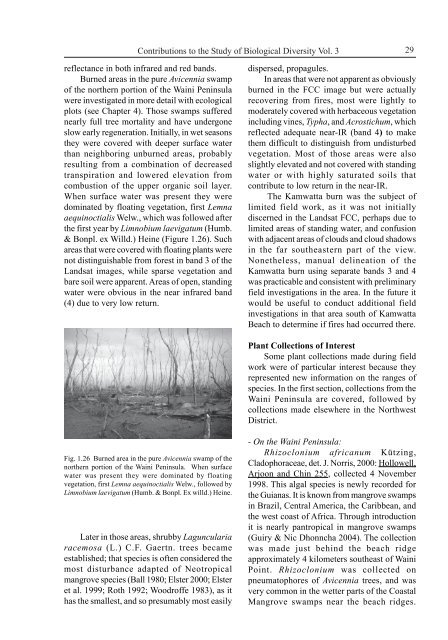Plant Community Structure, Fire Disturbance, and Recovery in ...
Plant Community Structure, Fire Disturbance, and Recovery in ...
Plant Community Structure, Fire Disturbance, and Recovery in ...
You also want an ePaper? Increase the reach of your titles
YUMPU automatically turns print PDFs into web optimized ePapers that Google loves.
Contributions to the Study of Biological Diversity Vol. 3<br />
reflectance <strong>in</strong> both <strong>in</strong>frared <strong>and</strong> red b<strong>and</strong>s.<br />
Burned areas <strong>in</strong> the pure Avicennia swamp<br />
of the northern portion of the Wa<strong>in</strong>i Pen<strong>in</strong>sula<br />
were <strong>in</strong>vestigated <strong>in</strong> more detail with ecological<br />
plots (see Chapter 4). Those swamps suffered<br />
nearly full tree mortality <strong>and</strong> have undergone<br />
slow early regeneration. Initially, <strong>in</strong> wet seasons<br />
they were covered with deeper surface water<br />
than neighbor<strong>in</strong>g unburned areas, probably<br />
result<strong>in</strong>g from a comb<strong>in</strong>ation of decreased<br />
transpiration <strong>and</strong> lowered elevation from<br />
combustion of the upper organic soil layer.<br />
When surface water was present they were<br />
dom<strong>in</strong>ated by float<strong>in</strong>g vegetation, first Lemna<br />
aequ<strong>in</strong>octialis Welw., which was followed after<br />
the first year by Limnobium laevigatum (Humb.<br />
& Bonpl. ex Willd.) He<strong>in</strong>e (Figure 1.26). Such<br />
areas that were covered with float<strong>in</strong>g plants were<br />
not dist<strong>in</strong>guishable from forest <strong>in</strong> b<strong>and</strong> 3 of the<br />
L<strong>and</strong>sat images, while sparse vegetation <strong>and</strong><br />
bare soil were apparent. Areas of open, st<strong>and</strong><strong>in</strong>g<br />
water were obvious <strong>in</strong> the near <strong>in</strong>frared b<strong>and</strong><br />
(4) due to very low return.<br />
Fig. 1.26 Burned area <strong>in</strong> the pure Avicennia swamp of the<br />
northern portion of the Wa<strong>in</strong>i Pen<strong>in</strong>sula. When surface<br />
water was present they were dom<strong>in</strong>ated by float<strong>in</strong>g<br />
vegetation, first Lemna aequ<strong>in</strong>octialis Welw., followed by<br />
Limnobium laevigatum (Humb. & Bonpl. Ex willd.) He<strong>in</strong>e.<br />
Later <strong>in</strong> those areas, shrubby Laguncularia<br />
racemosa (L.) C.F. Gaertn. trees became<br />
established; that species is often considered the<br />
most disturbance adapted of Neotropical<br />
mangrove species (Ball 1980; Elster 2000; Elster<br />
et al. 1999; Roth 1992; Woodroffe 1983), as it<br />
has the smallest, <strong>and</strong> so presumably most easily<br />
29<br />
dispersed, propagules.<br />
In areas that were not apparent as obviously<br />
burned <strong>in</strong> the FCC image but were actually<br />
recover<strong>in</strong>g from fires, most were lightly to<br />
moderately covered with herbaceous vegetation<br />
<strong>in</strong>clud<strong>in</strong>g v<strong>in</strong>es, Typha, <strong>and</strong> Acrostichum, which<br />
reflected adequate near-IR (b<strong>and</strong> 4) to make<br />
them difficult to dist<strong>in</strong>guish from undisturbed<br />
vegetation. Most of those areas were also<br />
slightly elevated <strong>and</strong> not covered with st<strong>and</strong><strong>in</strong>g<br />
water or with highly saturated soils that<br />
contribute to low return <strong>in</strong> the near-IR.<br />
The Kamwatta burn was the subject of<br />
limited field work, as it was not <strong>in</strong>itially<br />
discerned <strong>in</strong> the L<strong>and</strong>sat FCC, perhaps due to<br />
limited areas of st<strong>and</strong><strong>in</strong>g water, <strong>and</strong> confusion<br />
with adjacent areas of clouds <strong>and</strong> cloud shadows<br />
<strong>in</strong> the far southeastern part of the view.<br />
Nonetheless, manual del<strong>in</strong>eation of the<br />
Kamwatta burn us<strong>in</strong>g separate b<strong>and</strong>s 3 <strong>and</strong> 4<br />
was practicable <strong>and</strong> consistent with prelim<strong>in</strong>ary<br />
field <strong>in</strong>vestigations <strong>in</strong> the area. In the future it<br />
would be useful to conduct additional field<br />
<strong>in</strong>vestigations <strong>in</strong> that area south of Kamwatta<br />
Beach to determ<strong>in</strong>e if fires had occurred there.<br />
<strong>Plant</strong> Collections of Interest<br />
Some plant collections made dur<strong>in</strong>g field<br />
work were of particular <strong>in</strong>terest because they<br />
represented new <strong>in</strong>formation on the ranges of<br />
species. In the first section, collections from the<br />
Wa<strong>in</strong>i Pen<strong>in</strong>sula are covered, followed by<br />
collections made elsewhere <strong>in</strong> the Northwest<br />
District.<br />
- On the Wa<strong>in</strong>i Pen<strong>in</strong>sula:<br />
Rhizoclonium africanum Kütz<strong>in</strong>g,<br />
Cladophoraceae, det. J. Norris, 2000: Hollowell,<br />
Arjoon <strong>and</strong> Ch<strong>in</strong> 255, collected 4 November<br />
1998. This algal species is newly recorded for<br />
the Guianas. It is known from mangrove swamps<br />
<strong>in</strong> Brazil, Central America, the Caribbean, <strong>and</strong><br />
the west coast of Africa. Through <strong>in</strong>troduction<br />
it is nearly pantropical <strong>in</strong> mangrove swamps<br />
(Guiry & Nic Dhonncha 2004). The collection<br />
was made just beh<strong>in</strong>d the beach ridge<br />
approximately 4 kilometers southeast of Wa<strong>in</strong>i<br />
Po<strong>in</strong>t. Rhizoclonium was collected on<br />
pneumatophores of Avicennia trees, <strong>and</strong> was<br />
very common <strong>in</strong> the wetter parts of the Coastal<br />
Mangrove swamps near the beach ridges.
















